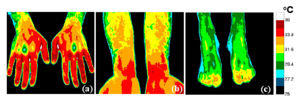Infrared sensing: Difference between revisions
imported>Howard C. Berkowitz |
imported>Howard C. Berkowitz (Merging and editing from other articles) |
||
| Line 12: | Line 12: | ||
LLTV still required some light to be present, and could not work through smoke, haze, or mist. | LLTV still required some light to be present, and could not work through smoke, haze, or mist. | ||
==1940s and 1950s== | ====1940s and 1950s==== | ||
WWII equipment, such as the M3 Sniperscope, included both a rifle modified to hold the infrared viewing system. A sniperscope, required a source of infrared light. Often, such a device had two side-by-side tubes, resembling a flashlight and telescope clamped together. The early versions also needed a rifle modified to hold the equipment. <ref name=FAN>{{citation | WWII equipment, such as the M3 Sniperscope, included both a rifle modified to hold the infrared viewing system. A sniperscope, required a source of infrared light. Often, such a device had two side-by-side tubes, resembling a flashlight and telescope clamped together. The early versions also needed a rifle modified to hold the equipment. <ref name=FAN>{{citation | ||
| url =http://ugca.org/07jan/night.htm | | url =http://ugca.org/07jan/night.htm | ||
| Line 41: | Line 41: | ||
==References== | ==References== | ||
{{reflist}} | {{reflist|2}} | ||
Revision as of 03:06, 13 March 2011
Infrared viewing encompasses a wide range of technologies that gather information using remote sensing in the infrared portion of the electromagnetic spectrum. Early techniques included "active" or "first generation night viewing", in which the viewer illuminated the area of interst with an infrared light, and viewed the reflections. Later technologies, often in different subparts of the infrared spectrum, passively received and amplified infrared-spectrum heat from the target.
Not all infrared viewing techniques produce a picture, but may produce matrices that assign wavelengths and intensity information to parts of the field being viewed. For example, Defense Support Program and successor satellites, which detect and track missile launchers, are "staring" arrays of infrared detectors that compare successive views. An intense heat pulse in one location shows the launch proper, but the data reduction system compares the heat in successive views to determine the direction and speed of missile travel.
Technologies
Applications
General military
Among the first uses of infrared viewing were military operations at night. The first infrared viewers were called "first generation night vision", which used an infrared illuminator light, and received reflections from the target. Military night vision moved away from infrared to visible light intensification, also called low-light television (LLTV), which amplified background starlighght, but the next generation returned to infrared, but using passive reception without an illuminator, but sensing heat radiated from the target and contrasting with its background. All are monochrome imaging displays, most often green on black, but sometime white or orange on black.
Active illumination with reflected viewing was simple, but had high power consumption, and, to an opponent with his own infrared viewer, the illuminator revealed the position of one's own system. The World War II generation was quite heavy; both power consumption and weight were reduced by the Korean War, but were still awkward. "Starlight scopes" of the Vietnam War was much lighter in weight and less demanding of batteries.
LLTV still required some light to be present, and could not work through smoke, haze, or mist.
1940s and 1950s
WWII equipment, such as the M3 Sniperscope, included both a rifle modified to hold the infrared viewing system. A sniperscope, required a source of infrared light. Often, such a device had two side-by-side tubes, resembling a flashlight and telescope clamped together. The early versions also needed a rifle modified to hold the equipment. [1]
Some of the limitations of this technology were that the infrared illuminator could require substantial electrical power, yet had limited range. Ranges from 100 to 400 yards were typical, with a black-and-green image. One WWII telescope and light source weighed approximately six pounds, but the necessary battery brought the total weight to 21 pounds. A Korean War version had a much sharper image, but a total weight of 28 pounds without greater range.
1960s
Low-light television (LLTV) work in the visible spectrum alone (or possibly near infrared), but lend themselves to display on a screen rather than goggles or a telescope-like sight. A number of aircraft, such as the the B-52, carry LLTV such as the AN/AVQ-22. Obviously, an airplane will not fly indoors, so the problem of not having skylight never occurs. Pilots of MH-53 PAVE LOW special operations helicopters often wear NVG.
If the device has light detectors sensitive to different colors (e.g., red-blue-green) LLTV gives color images, as opposed to the monochrome of passive NIR.[2]It thus can provide more information, as well as sharper views than a passive infrared viewer that uses longer wavelengths.
Thermal viewing
By going to shorter wavelengths of infrared light, third-generation IR NVD does not depend on reflections, but on the heat internal to a device. This still may pick up a metal object against earth, as the difference between the heat-conductive metal and the more insulating earth will be obvious. A tank engine, even hours after being turned off, still is hotter than the ground.
Missile launch detection
Medical
Most medical uses are imaging, and are displayed as false-color.
One research program compares multiple imaging methods in the difficult diagnosis of complex regional pain syndromes.[3]
References
- ↑ “Fight at Night!” — U.S. Army Night Vision, 1945-1980, Utah Gun Collectors' Association
- ↑ Keller, John (2006), "FLIR Systems multisensor device to help Army soldiers with urban warfare", Military & Aerospace Electronics November
- ↑ Imaging Reflex Synpathetic Dystropy, National Institutes of Health
